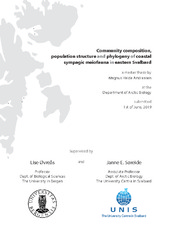| dc.description.abstract | Coastal sea ice communities constitute a highly vulnerable yet little investigated part of the Arctic ecosystem. A better understanding of the Arctic sea ice ecosystem will aid in more accurate predictions of the ecological response to current climate change. Sea ice communities comprise microalgae and meiofauna (20-500 μm) important to the existence and functioning of higher trophic levels. The response of sea ice-associated (sympagic) algae and meiofauna to cur- rent physical alterations in the Arctic will thus expectedly have ecosystem-wide consequences. Fundamental to the understanding of any ecosystem is knowledge on its taxa composition, species diversity and species functioning. This study investigated the community composition, population structure and phylogeny of coastal sympagic meiofauna in an unexplored region of eastern Sval- bard in March and April 2018. Ice cores were extracted for sympagic and pelagic meiofauna, chlo- rophyll a and physical variables in Inglefieldbukta and Agardhbukta. Microscope photography was applied to explore the size, feeding and reproduction of polychaetes and nematodes. Further, molecular barcoding aided in identifying sympagic polychaetes and nematodes from three addi- tional locations around Svalbard. Integrated sympagic meiofauna abundances ranged from 0 to 22 900 individuals m-2 with the most abundant and diverse communities occurring in April. Use of sea ice for overwintering, growth and reproduction was implied for nematodes, while polychaetes occurred only as feeding juveniles. Molecular analysis indicated the presence of two polychaete species not yet considered to be sympagic, Melaenis loveni and a Spio sp., and at least two nema- tode species not priorly described from Svalbard sea ice. The finding of M. loveni challenges the presumption of Scolelepis squamata as the resident sympagic polychaete in Svalbard. The nema- todes collected in this study likely provide the first molecular evidence for Theristus melnikovi and possibly the first sign of an Arctic sympagic species within the genus Halomonhystera. The above findings suggest eastern Svalbard to be a particular interesting area to conduct more extensive studies on the poorly known sympagic meiofauna and their fate in a melting Arctic. | en_US |
